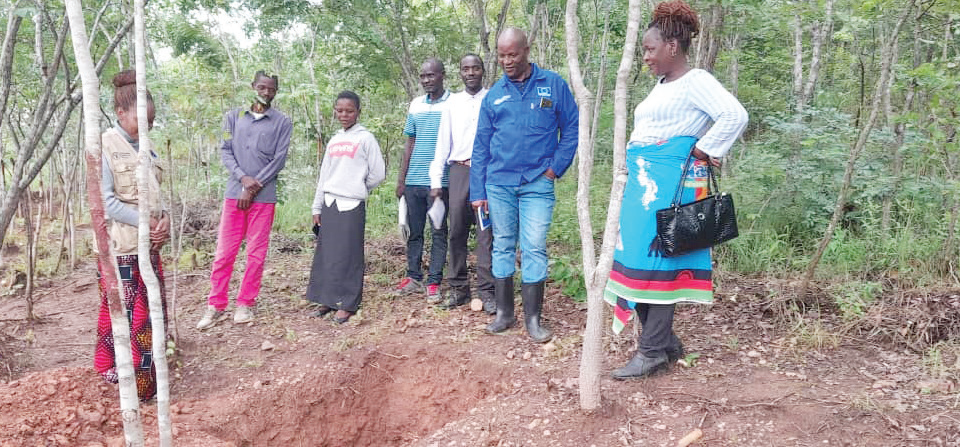Stuck on neglected trade route
For Andrew Kaonga and his three brothers, the journey from Chitipa to Mzuzu last week was meant to be an exciting reunion with their father in the city they love most. They joked, shared flashbacks and looked forward to an exciting stay in the evergreen city where their father had picked up a new job as a head teacher at Marymount Secondary School.
However, their excitement and optimism suddenly crumbled into uncertainty and desperation when their car stuttered to a sudden stop at Jalawe in Rumphi.
“All of a sudden, we heard cracking noise, the road surface was sinking and the vehicle was trapped in the shattered section and the tarmac was cutoff on both ends,” says Kaonga.
It was around 11pm when torrential rains left the damaged section of the M1 Road impassable, leaving the Kaongas with minor injuries in the process.

The cracking of the heavily patched tarmac, last rehabilitated by JR Construction from Germany in 2000, confirmed that the road has become an endangered trade route due to lack of repairs.
When the injured travellers were being treated at Jalawe, vehicles were piling into a traffic jam on the Northern Corridor, which offers the country a lifeline to the coastal port of Dar es Salaam in the neighbouring Tanzania.
“We returned from the hospital around 5am only to find a lengthy queue of vehicles which could not cross due to the cut off,” he says.
The long jam comprised trucks hauling fuel, bananas, maize and other goods that are either unavailable or in short supply locally. Besides the imports, there were busloads of travellers and traders commuting from Chitipa, Rumphi North and Karonga as well as the north-eastern neighbours. Also bringing the economy on its knees were truckloads of coal which were in transit from Karonga to Blantyre.
When tragedy struck, it rained heavily and Jalawe River, which snakes past the coal-rich Mchenga Hills on the way to Lake Malawi, broke its banks.
The river deposed huge rocks and logs that blocked a rusty culvert, forcing water to run freely on the cracked finish of the road. The raging run-off is thought to have soaked the thin layer on top of the culvert, weakening it precariously and it fell it when Kaonga’s Toyota Hilux arrived.
On the spot, we saw desperate travellers struggling to continue with their travels-and many were forced to drop out of buses and cross the sunken section on foot and with heavy luggage as they went to wait for scarce vehicles on the other side.
The worst hit were long-distance truckers who waited for up to nine hours when the road was temporarily repaired to allow the trucks carrying heavy-goods to pass.
Isaac Gondwe, who drives a Carlsberg Malawi truck which distributes various beverages in the North, was one of several long-distance drivers inconvenienced.
Leaning against his stationary truck, he spoke of “massive frustration as he was racing against the clock to deliver the drinks that were on the motionless truck.
“It’s a big inconvenience to our business of distributing drinks to our customers,” he says.
Locals in Jalawe say this is the second time in two years that the section has been cut off.
“We are lucky that no life was lost in both situations, but a worse heartbreak will happen unless a better bridge is erected on the death trap,” says Jalawe resident Boyson Khwati.
The setting between Bwengu in Mzimba and Lwezga on the border between Rumphi and Karonga is prone to floods, landslides and other accidents due to water and debris flowing from the nearby hills.
Almost every rainy season, the road suffers impassability.
Last year, the section around Mzokoto was buried in sand and mud. Likewise, a strip which winds past Chiweta Hills was clogged by landslides.
These misfortunes often bring businesses and travellers to a halt as is always the case on the M5, the lakeshore road which runs from Mukwiya in Nkhata Bay to Kaphatenga in Salima, which has had its fair share of the sink-ins and bridges being washed away.
Last month, a stretch between Salima and Nkhotakota suffered a sink-in which left travellers with no convenient alternative route.
For the recent case in Rumphi, truckers had no escape route as the steepness and narrowness of the hairpin bends on Chitimba-Livingstonia Road make the only alternative only usable by four-by-fours.
Patriot Vinkhumbo, a driver at Kapirimtende Transport, says cargo carriers were inconvenienced immensely as the M1 is the only corridor for heavy goods moving between this landlocked country and Tanzania’s coastal port and markets.
“The M1 Road is important to our economy and the government needs to maintain it periodically,” he says.
Presently, the neglected trade route is worn out, with vehiclesscrambling for the white line as they avoid ramming into potholes and jagged edges.
The poor state puts road users at the risk of accidents and further delays the transportation of cargo which keeps the economy ticking.
Vinkhumbo says: “The culverts have outlived their lifespan and the road itself is becoming smaller in width due to lack of maintenance. This is very risky to us truck drivers, most specifically during night travels.”
This is the road President Peter Mutharika, speaking at the launch of construction of Chitimba-Livingstonia-Njakwa Road, promised to start rehabilitating as early as June 2015.
It is getting worse as the wait continues.
The Roads Authority (RA) will reportedly install reinforced concrete box culverts at Jalawe as a long-term solution.
“The authority intends to commence implementation of these works in the shortest time possible once the necessary approvals are granted,” says RA spokesperson Portia Kajanga.
However, she said RA has been carrying out periodic maintenance of different sections of the 1 156-metre M1 to extend its lifespan.
She indicated the authority is undertaking a feasibility study and drawing detailed engineering design for the rehabilitation of the rundown section between Kacheche and Chiweta, but “implementation will be dependent on availability of funds”. n





